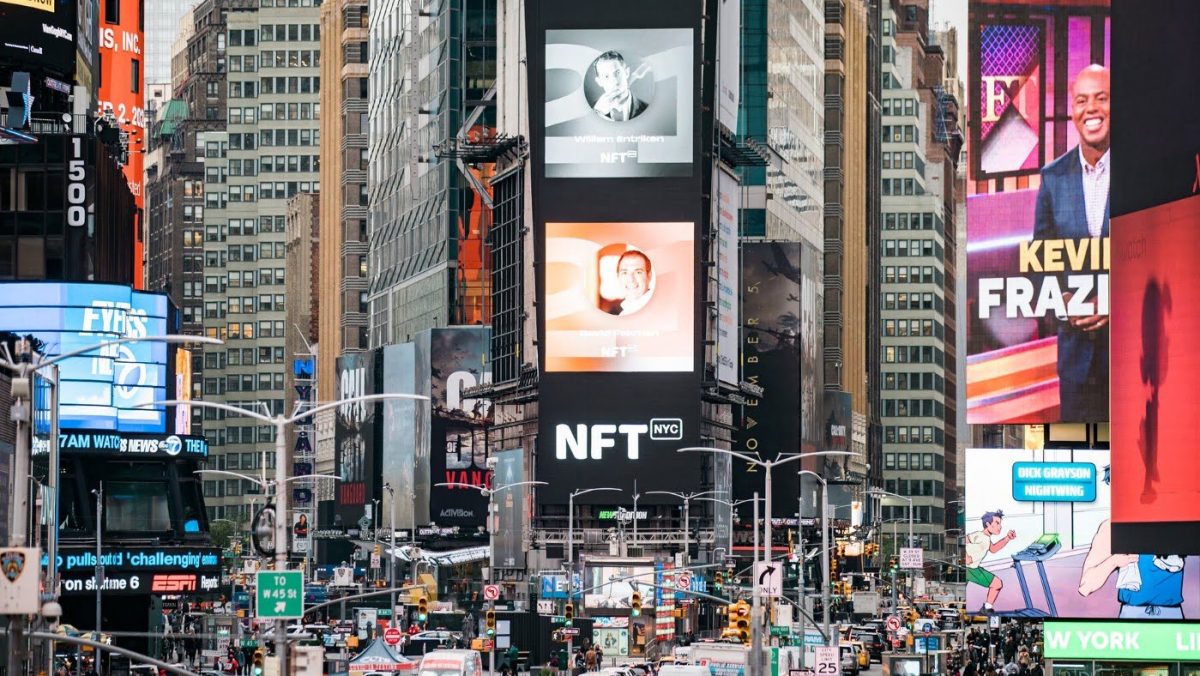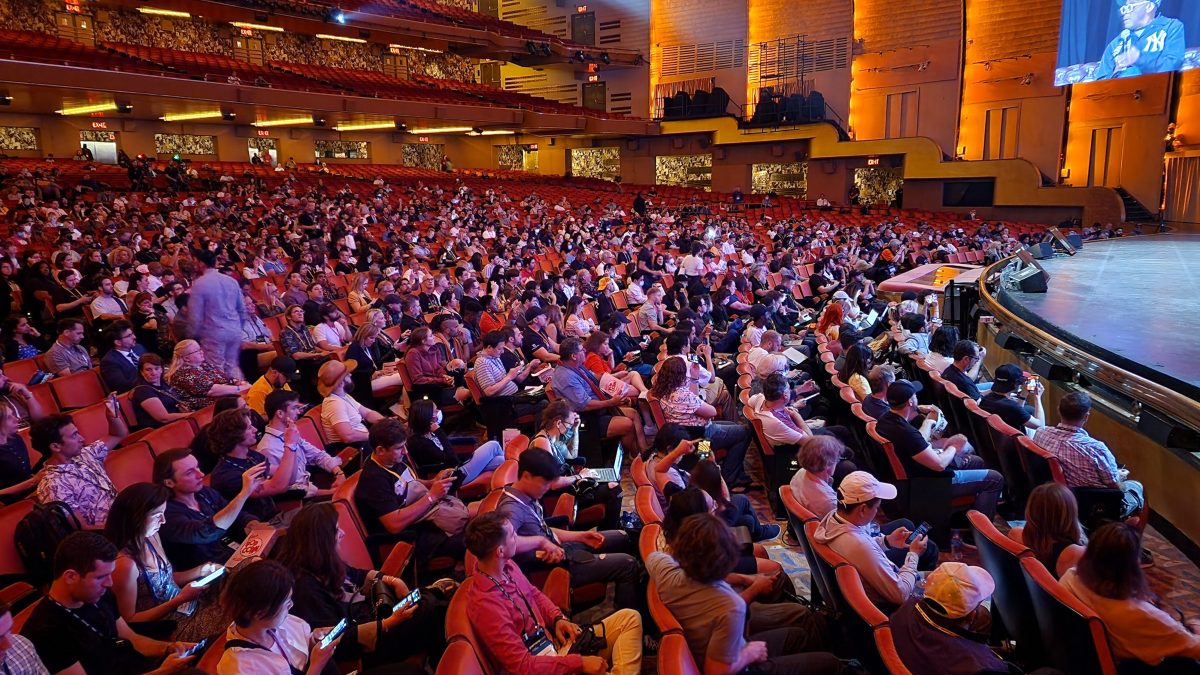Why NFT events are broken
The memes spread far and fast. “No way NFT.London was paying £600 entry for this to be the art gallery,” November 5 tweet read above a photograph showing what appeared to be a dreary office corridor doing its best impersonation of an art gallery. A smattering of small screens displaying NFT artwork by XCOPY, Alyssa Stevens and others populated the transient space in seemingly random order.
Overall, the scenario screamed laziness, incompetence, or a combination of the two. Surely, a massive Web3 IRL activation would put more emphasis on how it displayed community art, people thought. In the following minutes and hours, the NFT community fired some excellent pointed memes based on the image, a collective visual manifestation of the saying “If we didn’t laugh, we would cry.”
But this is a symptom of something deeper: NFT events are facing an identity crisis. Although often hailed as excellent IRL opportunities for Web3 enthusiasts to network, view art installations, and listen to panel talks by leading community figures, many have come to question the effectiveness of the events and the intentions of those who organize them. Community members are now wondering if they really add the value to the community that their organizers claim they do. Some have even gone so far as to say that large-scale NFT events are just a predatory echo of Web2 in Web3 clothing, little more than a way to fleece the community that built the space as we now know it. But how valid is such criticism?
No event in the space is more famous than NFT.NYC. The annual conference features everything an NFT lover could hope for, including panel talks, performances, art exhibitions and satellite events. It also attracts some of the biggest celebrities, CEOs and NFT collectors out there. But as the event has grown in size, status and pricing over the past three years, many in the NFT community now feel it has become a bloated cash grab.
Cameron Bale and Jodee Rich co-founded NFT.NYC – the company that organized this year’s first NFT.London – in 2018, after the two recognized a need to host an event for a nascent but rapidly growing NFT society. Rich and Bale also serve as CEO and Director of Marketing and Product Development, respectively, for NFT.Kred, a Web3 company that helps brands create NFT experiences and engagements for their audiences.
“Talking about NFTs in early 2018 mostly fell on deaf ears, as most people at blockchain and crypto events were focused on ICOs,” Bale said of the event’s history while speaking to nft now. “NFT.NYC was born out of the need to provide the community with a place to connect.”
“At NFT.London, more than 1,000 tickets, almost half, were given away for free to speakers, artists and community members who simply couldn’t afford it.”
Cameron Bale
The event has been an undeniable success in bringing people together. In 2019, the couple organized the first ever NFT.NYC. 460 people participated. Fast forward to 2022, and NFT.NYC hosted more than 15,000 attendees, according to figures provided by the company.
These are impressive numbers, especially given the fact that tickets for the three-day festival ranged from $500 to $2,000. This price range has been the source of much contention in the Web3 space, with a planned speaker for this year’s NFT.NYC even calling for boycott of the eventwith reference to poor organization and exploitative practices towards both the panel guests and the participants.

Responding to criticism that NFT.NYC and NFT.London’s ticket prices are out of reach for the average NFT enthusiast, especially in a bear market, Bale emphasized that they are trying to make the event as accessible as possible while maintaining some ticket revenue to help to finance. the festival together with the support of their sponsors.
“At NFT.London, more than 1,000 tickets, almost half, were given away for free to speakers, artists and community members who simply couldn’t afford it,” Bale said. “We will continue to offer different ways for people to participate in NFT.NYC events, regardless of budget.”
Bale also added that much of the criticism that NFT.London received came from people who did not attend the event, and went on to say that they received “overwhelmingly positive feedback” from those who did. The criticisms, he said, including viral tweets showing haphazardly assembled art exhibits and empty theater rooms during panel discussions, are taken out of context and do not represent the reality on the ground.
While there is credibility to that idea, it is also somewhat debatable. Some of the NFT.London attendees claim that some, if not many, of the event’s talks actually were sparsely populated and overwhelming. That the claim is disputed of some of the event’s speakers and participants which says panels may have been underpopulated due to scheduling conflicts or crowds gathering elsewhere in the venue. Overall, they say, the attendance was respectable. It is a difficult calculation to calibrate. With the event featuring dozens upon dozens of talks hosted by several hundred speakers over the festival’s two-day run, it was inevitable that some talks would be more well-attended than others.
Beyond NFT event pricing
However, pricing is not the only problem that critics of large NFT events cite. Singer-songwriter and Web3 spokesperson Rae Isla has experience on both sides of the NFT event fence, having organized the music programming for 2022’s NFT Seattle as well as an unaffiliated music satellite event at NFT.NYC this year, called the Web3 Singer/Songwriter Showcase . She believes that NFT events are less troubled by price problems and more by logistical ones.
“I don’t think there’s anything wrong with the price,” Isla said while speaking to nft now. “I think the problem is that those who throw these events try to do too many things, without recognizing the fact that there are specialists right in front of them who can cure different passion verticals, and maybe even do it on a voluntary basis.”
“I think what’s missing [in these events] involving the community as experts to come in and actually work on the events.”
Rae Isla
Music industry professionals, not people who only have experience in creating corporate events, as Isla offers as an example, should be the ones responsible for organizing and executing music-related events and performances at NFT events. Nor should non-artists curate galleries at these festivals, she stressed. One of the reasons behind NFT Seattle’s success, she said, is that event organizers trusted her to execute the programming in an organic and community-driven way.
“I think what’s missing [in these events] involving the community as experts to come in and actually work on the events,” offered Isla as a potential area of improvement. “The reaction to it can be [the organizers] saying they need more money to pay people. Well, then find more money. Maybe the real push needs to be telling companies that have funding that if they don’t invest real dollars into the culture of the Web3 space, it won’t happen. So they have to contribute more financially if they want these events to have an effect.”

Isla advocates making NFT events modular so that participants can pick and choose which days, lectures and performances they actually want to attend. Diversifying the access routes to these festivals, she said, could be a way to lower the entry barrier for the community while ensuring that scheduled lectures and performances do not suffer from over- or under-attendance.
“If you want to see Billy Eilish or Kendrick Lamar or the Foo Fighters [at a music festival], you end up buying a weekend pass because you don’t want to miss that one show,” Isla explained. “It’s a strategic way to get people to buy these passes. But people shouldn’t be forced to sit through a bunch of stuff they’re not interested in. I think the way to make [NFT] events worth the ticket price and more meaningful for those involved is to trust that curators, tastemakers and people who have earned their stripes in various passion verticals take ownership of certain aspects of the conference.”
When asked what type of collaboration Isla advocates for in event building, Bale emphasized that NFT.NYC is more than happy to collaborate with members of the community. “We are technologists, not a trade show,” Bale said. “[We] is deeply committed to working with the community.”
IRL events do good, even when they don’t
Speaking about the ambient success that events like NFT.NYC create, Bale noted that the annual festival has grown to have its own kind of gravity. This gravity attracts the NFT community to the city, fosters community, creates opportunities for brands and project creators, and boosts the local economy in the process.
It is hard to deny these effects. Any community that exists primarily in the digital sphere needs such events if it wants to grow and enrich itself. Regardless of these events’ faults, they will almost always be a net positive for society because of that fact alone. Bale clearly recognizes this.
“The biggest memory for me personally was the sense of togetherness we were able to create in 2021 after so many people had been isolated for so long,” he said of the post-pandemic nature of this year’s event. “It was a family reunion of sorts for the community, many of whom were meeting friends IRL for the first time!”
Organizers can do better
We should celebrate moments of togetherness and community, no matter the circumstances. But that doesn’t mean there isn’t room for improvement. NFT events can and should make their communities better, which means learning to read the dynamic space of morality and ethics throughout the Web3 space.
But it is not easy, because ethos is difficult. The founding principles of Web3, like the founding principles of any large community, are not immutable – they require defense. In recent months, NFT enthusiasts have had to band together to push back against practices (both proposed and implemented) that disenfranchise the very people who built the space. Web3’s biggest advocates only have the right to relate to the rhetoric about decentralization and a level playing field if they are to concretely back it up with action and live by these principles.
Inclusion must be one of them. Community members looking at an NFT space that at times feels like it’s quickly outgrowing their wallet’s reach, never to return, are right to call out events that are meant to foster community, yet inherently prevent the majority of the society that participates in them. It is for this reason that we at nft are now proud to have created The Gateway, our five-day event in Miami during Art Basel in December 2022, which was free and open to all.
Future major events such as 2023’s NFT. NYC and NFT.London will serve as a barometer of how the community decides to interact with IRL activations and how much it is willing to pay for them. So far, NFT.NYC 2023 is shaping up to be another showcase on a grand scale. With tickets ranging from $500 to $1,500 and featuring a 25,000-square-foot rooftop pavilion, gaming arena and more, Bale and company show no signs of slowing down. Time will tell if such continued grandiosity will serve it well.
After the 2021 bull run ended and the latest crypto winter began in earnest, Web3’s proponents realized how much unnecessary weight it had accumulated. The NFT and crypto space is now much thinner than it was last year, but it has gained the mobility and dexterity it needs to help it escape and far surpass the shadows of the bear market. NFT organizers should take note. The best part of wisdom may be to streamline IRL events before they shake apart with cost and drama.


